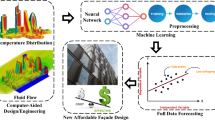Abstract
The energy consumption of heating, ventilation, and air conditioning (HVAC) systems holds a significant position in building energy usage, accounting for about 65% of the total energy consumption. Moreover, with the advancement of building automation, the energy consumption of ventilation systems continues to grow. This study focuses on improving the performance of spherical tuyeres in HVAC systems. It primarily utilizes neural networks and multi-island genetic algorithms (MIGA) for multi-parameter optimization. By employing methods such as structural parameterization, accurate and fast computational fluid dynamics (CFD) simulations, a minimized sample space, and a rational optimization strategy, the time cycle of the optimization process is shortened. Additionally, a new comprehensive evaluation index is proposed in this research to describe the performance of spherical tuyeres, which can be used to more accurately assess spherical tuyeres with different structures. The results show that by establishing a neural network prediction model and combining it with the multi-island genetic algorithm, a novel spherical tuyere design was successfully achieved. The optimized novel spherical tuyeres achieved a 27.05% reduction in the spherical tuyeres effective index (STEI) compared to the traditional spherical tuyeres. Moreover, the resistance decreased by 15.68%, and the jet length increased by 7.57%. The experimental results demonstrate that our proposed optimization method exhibits high accuracy, good generalization capability, and excellent agreement at different Reynolds numbers.
Similar content being viewed by others
References
Ahmed AQ, Gao S (2017). Numerical investigation of height impact of local exhaust combined with an office work station on energy saving and indoor environment. Building and Environment, 122: 194–205.
ASHRAE (2017). ASHRAE Handbook: Fundamentals. Atlanta, GA, USA: American Society of Heating, Refrigerating and Air Conditioning Engineers.
Aslam Bhutta MM, Hayat N, Bashir MH, et al. (2012). CFD applications in various heat exchangers design: A review. Applied Thermal Engineering, 32: 1–12.
Aziz MA, Gad IAM, Mohammed ESFA, et al. (2012). Experimental and numerical study of influence of air ceiling diffusers on room air flow characteristics. Energy and Buildings, 55: 738–746.
Benchikh Le Hocine AE, Poncet S, Fellouah H (2021). CFD modeling and optimization by metamodels of a squirrel cage fan using OpenFoam and Dakota: Ventilation applications. Building and Environment, 205: 108145.
Bu Y-P, Song W-P, Han Z, et al. (2022). Efficient aerostructural optimization of helicopter rotors toward aeroacoustic noise reduction using multilevel hierarchical kriging model. Aerospace Science and Technology, 127: 107683.
Caciolo M, Stabat P, Marchio D (2012). Numerical simulation of single-sided ventilation using RANS and LES and comparison with full-scale experiments. Building and Environment, 50: 202–213.
Cao Z, Wang Y, Zhai C, et al. (2018). Performance evaluation of different air distribution systems for removal of concentrated emission contaminants by using vortex flow ventilation system. Building and Environment, 142: 211–220.
China Institute of Architectural Design Standards (2011). The Selection and Installation of the Air Supply Outlet Manual. (in Chinese)
Du D, He E, Li F, et al. (2020). Using the hierarchical Kriging model to optimize the structural dynamics of rocket engines. Aerospace Science and Technology, 107: 106248.
Fan Y, Wang Z, Fu T (2021). Multi-objective optimization design of lithium-ion battery liquid cooling plate with double-layered dendritic channels. Applied Thermal Engineering, 199: 117541.
Gao R, Liu M, Zheng Q, et al. (2021). High-efficiency diffuser based on a normalized evaluation index of jet length and resistance. Building and Environment, 195: 107737.
Hu SC (2003). Airflow characteristics in the outlet region of a vortex room air diffuser. Building and Environment, 38: 553–561.
Hu H (2019). Research on parallel iterative optimization based on BP neural network and genetic algorithm. Machinery & Electronics, 37(1): 26–32. (in Chinese)
Huang X (2006). Air Conditioning Engineering. Beijing: Mechanical Industry Press. (in Chinese)
Huang T, Rong L, Zhang G (2022). Investigating the feasibility of using computational fluid dynamics based response surface methodology and neural network to model the performance of the individualised ventilation in sow houses. Biosystems Engineering, 214: 138–151.
JG/T 20-1999 (1999). Method of Testing for Rating Air Distributor Performance. Ministry of Construction of China. (in Chinese)
Jia Z, Xu L, Duan X, et al. (2022). CFD simulation of flow and mixing characteristics in a stirred tank agitated by improved disc turbines. Chinese Journal of Chemical Engineering, 50: 95–107.
Jones DR, Schonlau M, Welch WJ (1998). Efficient global optimization of expensive black-box functions. Journal of Global Optimization, 13: 455–492.
Kulkarni V, Sahoo N, Chavan SD (2011). Simulation of honeycomb-screen combinations for turbulence management in a subsonic wind tunnel. Journal of Wind Engineering and Industrial Aerodynamics, 99: 37–45.
Li A (2004). The scientific basis about efficient shutters and hoods for natural ventilation. Master Thesis, Xi’an University of Architecture and Technology, China. (in Chinese)
Li C (2013). A surrogate-based framework with hybrid refinement strategies for aerodynamic shape optimization. DLR Deutsches Zentrum fur Luft- und Raumfahrt e. V. — Forschungsberichte, 87: 123–137.
Li A, Ren T, Yang C, et al. (2018). Numerical simulation, PIV measurements and analysis of air movement influenced by nozzle jets and heat sources in underground generator hall. Building and Environment, 131: 16–31.
Li H (2020). Study on the resistance and characteristics of tuyere under the condition of insufficient development flow. Master Thesis, Xi’an University of Architecture and Technology, China. (in Chinese)
Liu P (2008). Theory of Turbulent Kinematic Flow. Beijing: Beihang University Press. (in Chinese)
Liu X, Guo J, Wang H, et al. (2022). Prediction of stock market index based on ISSA-BP neural network. Expert Systems with Applications, 204: 117604.
Liu M, Gao R, Jing R, et al. (2023). A high-efficiency circle diffuser with low resistance and high jet length. Energy and Buildings, 296: 113399.
Lu H, Lu L (2015). Numerical investigation on particle deposition enhancement in duct air flow by ribbed wall. Building and Environment, 85: 61–72.
Lv M (2009). Experimental research on the performance of jet inducted fan’s nozzle. Master Thesis, Tianjin University, China. (in Chinese)
Ma Y, Li L, Yin Z, et al. (2021). Research and application of network status prediction based on BP neural network for intelligent production line. Procedia Computer Science, 183: 189–196.
Malmström TG, Kirkpatrick AT, Christensen B, et al. (1997). Centreline velocity decay measurements in low-velocity axisymmetric jets. Journal of Fluid Mechanics, 346: 363–377.
Nie S, Hong R, Ji H, et al. (2022). A hybrid of surrogate model and MIGA method for optimization and compensation of steady-state flow force on water hydraulic HSV. Flow Measurement and Instrumentation, 86: 102176.
Regis RG, Shoemaker CA (2005). Constrained global optimization of expensive black box functions using radial basis functions. Journal of Global Optimization, 31: 153–171.
Sajadi B, Saidi MH, Mohebbian A (2011). Numerical investigation of the swirling air diffuser: Parametric study and optimization. Energy and Buildings, 43: 1329–1333.
Senanayake P, Salati H, Wong E, et al. (2021). The impact of nasal adhesions on airflow and mucosal cooling—A computational fluid dynamics analysis. Respiratory Physiology & Neurobiology, 293: 103719.
Shi W, Liu J, Zhang J, et al. (2022). Feature selection and parameter optimization of support vector machines based on a local search based firefly algorithm for classification of formulas in traditional Chinese medicine. IEICE Transactions on Fundamentals of Electronics, Communications and Computer Sciences, E105.A: 882–886.
Song G (2005). Visualization of the airflow patterns of 12 typical diffusers and experimental investigation on the turbulent coefficient. Master Thesis, Xi’an University of Architecture and Technology, China. (in Chinese)
Sun Q (2021). Sequence iterative optimization based on adaptive surrogate model and its application. Master Thesis, North University of China, China. (in Chinese)
Tian J, Liu Y, Zheng W, Yin L (2022). Smog prediction based on the deep belief-BP neural network model (DBN-BP). Urban Climate, 41: 101078.
Tsinghua Building Energy Research Center (2018). Annual Report on China, Building Energy Efficiency, Beijing: China Architecture and Building Press. (in Chinese)
Vo DT, Mai TD, Kim B, et al. (2022). Numerical study on the influence of coolant temperature, pressure, and thermal barrier coating thickness on heat transfer in high-pressure blades. International Journal of Heat and Mass Transfer, 189: 122715.
Wang GG, Shan S (2007). Review of metamodeling techniques in support of engineering design optimization. Journal of Mechanical Design, 129: 370–380.
Wang P, Han H, Liu R, et al. (2020). Effect of outlet diameter on atomization characteristics and dust reduction performance of X-swirl pressure nozzle. Process Safety and Environmental Protection, 137: 340–351.
Wu X (2020). Study on structural optimization of air volume hood for volume measurement of spherical nozzle. Master Thesis, University of South China, China. (in Chinese)
Wu S, Dong J, Xu S, et al. (2021). Optimization of a segmented mirror with a global radius of curvature actuation system based on multi-fidelity surrogates. Optik, 242: 166741.
Xu Y (2020). Experimental study on the airflow characteristics of the interaction between nozzle jets and plumes formed by interior heat sources in large spaces based on two-dimensional particle image velocimetry (2D-PIV). Master Thesis, University of Shanghai for Science & Technology, China. (in Chinese)
Yoo W, Jeon S, Son C, et al. (2016). Full surface heat transfer characteristics of rotor ventilation duct of a turbine generator. Applied Thermal Engineering, 94: 385–394.
Zhang D, Lou S (2021). The application research of neural network and BP algorithm in stock price pattern classification and prediction. Future Generation Computer Systems, 115: 872–879.
Zhang C, Li A, Guo J, et al. (2021a). Jet noise reduction of spherical tuyeres with serrated trailing edges. Journal of Building Engineering, 44: 103324.
Zhang D, Wang Z, Ling H, et al. (2021b). Kriging-based shape optimization framework for blended-wing-body underwater glider with NURBS-based parametrization. Ocean Engineering, 219: 108212.
Zhang H, Zhang W, Zhang W, et al. (2022). Multi-vent module-based adaptive ventilation to reduce cross-contamination among indoor occupants. Building and Environment, 212: 108836.
Zhao M (2019). Numerical simulation of air distribution in cruise accommodation and optimization of tuyere structure. Master Thesis, Harbin Engineering University, China. (in Chinese)
Zhou Z, Tan H, Pan D (2010). Study of the applicability of jet theory for large space air conditioning. Heating Ventilating & Air Conditioning, 40(2): 123–127. (in Chinese)
Zhou W, Wang S, Zhu J, et al. (2022). Parameter optimization and experimental study of jet mixing device based on CFD. Processes, 10: 933.
Acknowledgments
This research project was sponsored by the National Natural Science Foundation of China General Program (No. 52178090 and No. 51878533) and the Science and Technology New Star Project of Shaanxi Province (No. 2020KJXX-013).
Author information
Authors and Affiliations
Contributions
Mengchao Liu: conceptualization, methodology, software, writing—original draft. Ran Gao: data curation, writing—original draft. Yi Wang: visualization, investigation. Angui Li: resources, supervision.
Corresponding author
Ethics declarations
The authors have no competing interests to declare that are relevant to the content of this article
Rights and permissions
About this article
Cite this article
Liu, M., Gao, R., Wang, Y. et al. Optimization study of spherical tuyere based on BP neural network and new evaluation index. Build. Simul. 17, 223–234 (2024). https://doi.org/10.1007/s12273-023-1075-4
Received:
Revised:
Accepted:
Published:
Issue Date:
DOI: https://doi.org/10.1007/s12273-023-1075-4




